|
|
|
Sort Order |
|
|
|
Items / Page
|
|
|
|
|
|
|
| Srl | Item |
| 1 |
ID:
072551
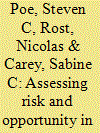

|
|
|
|
|
| Publication |
2006.
|
| Summary/Abstract |
Over the past two decades, substantial progress has been made toward a theoretical understanding of why physical integrity abuses are committed. Unfortunately, these theoretical developments have been devoid of much practical application. In this article, the authors explore the feasibility of risk assessment in the study of these human rights. Borrowing an approach by Gurr and Moore, they construct a risk assessment vehicle that uses existing models and data to develop expectations about future increases and decreases in human rights abuses. Their results indicate that we can isolate a set of cases that are at a higher risk of experiencing increased human rights abuse in the following year, as well as those that are ripe for better protection of human rights. The authors expect these risk and opportunity assessments to be of interest to students of conflict and peace studies, as well as to human rights activists and policy makers.
|
|
|
|
|
|
|
|
|
|
|
|
|
|
|
|
| 2 |
ID:
152296
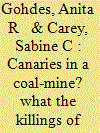

|
|
|
|
|
| Summary/Abstract |
An independent press that is free from government censorship is regarded as instrumental to ensuring human rights protection. Yet governments across the globe often target journalists when their reports seem to offend them or contradict their policies. Can the government’s infringements of the rights of journalists tell us anything about its wider human rights agenda? The killing of a journalist is a sign of deteriorating respect for human rights. If a government orders the killing of a journalist, it is willing to use extreme measures to eliminate the threat posed by the uncontrolled flow of information. If non-state actors murder journalists, it reflects insecurity, which can lead to a backlash by the government, again triggering state-sponsored repression. To test the argument whether the killing of journalists is a precursor to increasing repression, we introduce a new global dataset on killings of journalists between 2002 and 2013 that uses three different sources that track such events across the world. The new data show that mostly local journalists are targeted and that in most cases the perpetrators remain unconfirmed. Particularly in countries with limited repression, human rights conditions are likely to deteriorate in the two years following the killing of a journalist. When journalists are killed, human rights conditions are unlikely to improve where standard models of human rights would expect an improvement. Our research underlines the importance of taking the treatment of journalists seriously, not only because failure to do so endangers their lives and limits our understanding of events on the ground, but also because their physical safety is an important precursor of more repression in the future.
|
|
|
|
|
|
|
|
|
|
|
|
|
|
|
|
| 3 |
ID:
078639
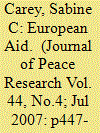

|
|
|
|
|
| Publication |
2007.
|
| Summary/Abstract |
Most studies on foreign aid and human rights have ignored the role of bureaucratic inertia in the allocation process. By not controlling for which developing countries have received aid in the past and how much aid they have received, continuity of aid flows remains unaccounted for. Additionally, previous studies have not allowed for a possible non-linear relationship between human rights and aid. This study investigates aid commitments from the European Commission, Germany, France, and the UK, paying attention to non-linear effects of human rights on aid commitments and the role of bureaucratic inertia. Using data from 1978 to 2003, the study investigates how past aid commitments, the level of human rights violations, and substantial changes in the respect for human rights influence the decision of European donors on whom to give aid to, how to choose a new recipient country that did not receive aid previously, and how much aid to give to countries that made it past the gatekeeping stage. Controlling for various donor interests and recipient needs, the results show that, despite donors' emphasis on human rights in official documents, the human rights situation in developing countries does not consistently shape European aid commitments. Only Germany commits less aid to more repressive countries. However, recent substantial improvements of the human rights records are rewarded by both Germany and France when deciding whom to give aid to. Bureaucratic inertia seems to be a major obstacle to the consistent implementation of human rights consideration in European aid allocation
|
|
|
|
|
|
|
|
|
|
|
|
|
|
|
|
| 4 |
ID:
141183
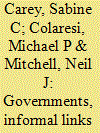

|
|
|
|
|
| Summary/Abstract |
From Syria to Sudan, governments have informal ties with militias that use violence against opposition groups and civilians. Building on research that suggests these groups offer governments logistical benefits in civil wars as well as political benefits in the form of reduced liability for violence, we provide the first systematic global analysis of the scale and patterns of these informal linkages. We find over 200 informal state–militia relationships across the globe, within but also outside of civil wars. We illustrate how informal delegation of violence to these groups can help some governments avoid accountability for violence and repression. Our empirical analysis finds that weak democracies as well as recipients of financial aid from democracies are particularly likely to form informal ties with militias. This relationship is strengthened as the monitoring costs of democratic donors increase. Out-of-sample predictions illustrate the usefulness of our approach that views informal ties to militias as deliberate government strategy to avoid accountability.
|
|
|
|
|
|
|
|
|
|
|
|
|
|
|
|
| 5 |
ID:
146183
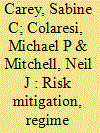

|
|
|
|
|
| Summary/Abstract |
In Thailand, India, Libya, and elsewhere, governments arm the populace or call up volunteers in irregular armed groups despite the risks this entails. The widespread presence of these militias, outside the context of state failure, challenges the expectation that governments uniformly consolidate the tools of violence. Drawing on the logic of delegation, we resolve this puzzle by arguing that governments have multiple incentives to form armed groups with a recognized link to the state but outside of the regular security forces. Such groups offset coup risks as substitutes for unreliable regular forces. Similar to other public-private collaborations, they also complement the work of regular forces in providing efficiency and information gains. Finally, these groups distance the government from the controversial use of force. These traits suggest that militias are not simply a sign of failed states or a precursor to a national military, but an important component of security portfolios in many contexts. Using cross-national data (1981–2005), we find support for this mix of incentives. From the perspective of delegation, used to analyze organizational design, global accountability, and policy choices, the domestic and international incentives for governments to choose militias raise explicit governance and accountability issues for the international community.
|
|
|
|
|
|
|
|
|
|
|
|
|
|
|
|
| 6 |
ID:
121801
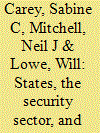

|
|
|
|
|
| Publication |
2013.
|
| Summary/Abstract |
This article introduces the global Pro-Government Militias Database (PGMD). Despite the devastating record of some pro-government groups, there has been little research on why these forces form, under what conditions they are most likely to act, and how they affect the risk of internal conflict, repression, and state fragility. From events in the former Yugoslavia, Iraq, Sudan, or Syria and the countries of the Arab Spring we know that pro-government militias operate in a variety of contexts. They are often linked with extreme violence and disregard for the laws of war. Yet research, notably quantitative research, lags behind events. In this article we give an overview of the PGMD, a new global dataset that identifies pro-government militias from 1981 to 2007. The information on pro-government militias (PGMs) is presented in a relational data structure, which allows researchers to browse and download different versions of the dataset and access over 3,500 sources that informed the coding. The database shows the wide proliferation and diffusion of these groups. We identify 332 PGMs and specify how they are linked to government, for example via the governing political party, individual leaders, or the military. The dataset captures the type of affiliation of the groups to the government by distinguishing between informal and semi-official militias. It identifies, among others, membership characteristics and the types of groups they target. These data are likely to be relevant to research on state strength and state failure, the dynamics of conflict, including security sector reform, demobilization and reintegration, as well as work on human rights and the interactions between different state and non-state actors. To illustrate uses of the data, we include the PGM data in a standard model of armed conflict and find that such groups increase the risk of civil war.
|
|
|
|
|
|
|
|
|
|
|
|
|
|
|
|
| 7 |
ID:
080821
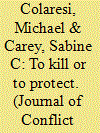

|
|
|
|
|
| Publication |
2008.
|
| Summary/Abstract |
Contemporary studies of genocide have found military capabilities to be inconsistent predictors of state-sponsored killings. We suggest that these empirical inconsistencies stem from the fact that government strength can serve two opposing purposes. Some level of armed capabilities is necessary for a state to remain viable and to provide internal and external security. Yet armed government personnel can be deployed to repress and destroy segments of the public. We identify conditions under which an executive is more likely to use security forces for private-interest killing rather than public protection. We hypothesize that unconstrained leaders are more likely to use their putative security forces to initiate genocide and remain in power. An analysis of state failures that lead to genocide robustly supports the idea that the effect of increased security forces on the risk of genocide is conditional on institutional executive constraints
|
|
|
|
|
|
|
|
|
|
|
|
|
|
|
|
|
|
|
|
|